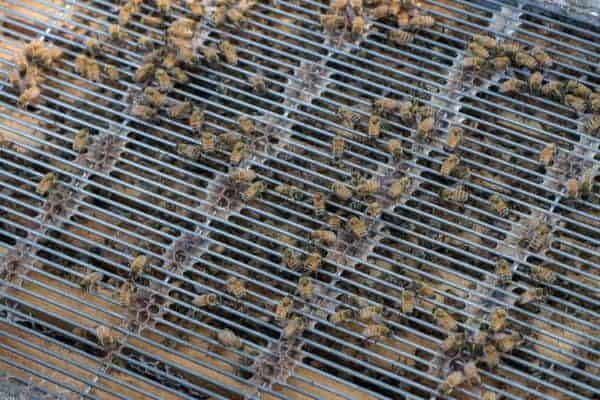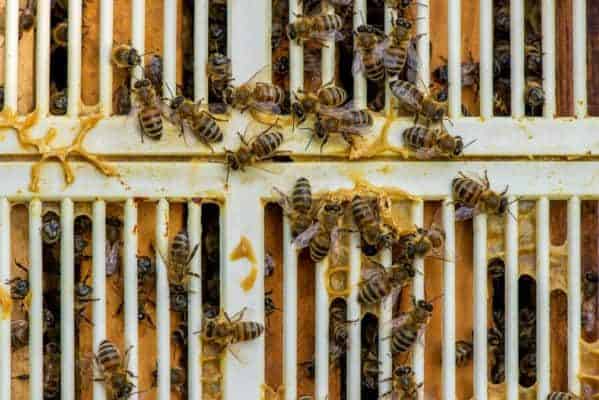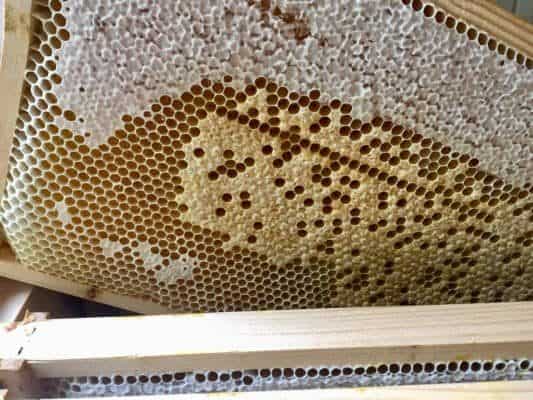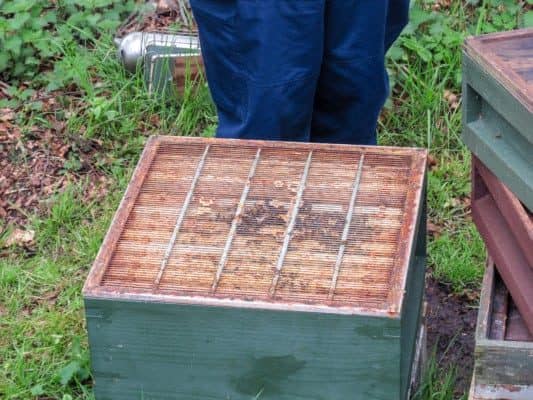Beekeeping is a wonderfully varied activity for hobbyists and along your journey, you will be faced with a variety of questions on how to look after your colony. One such question is how does a queen bee excluder work and do you need one?
A queen excluder is a physical barrier between the brood box and the honey super above. The excluder has holes just large enough for worker bees to pass through while blocking the larger queen bee. With the queen in the brood box, the honey super is free from brood meaning the honey can be taken without risk of brood cells being on the frames.

Why don’t all beekeepers use them?
Today we’ll take a closer look at the queen bee excluder and what it does. All your burning questions about queen bee excluders will be answered during the duration of this article including why the queen bee excluder has sometimes been a source of disagreement and debate in the beekeeping community at large.
What Is A Queen Excluder?
To properly grasp the contentious nature of the queen excluder, it would help to understand what exactly it is. A straightforward explanation is that it is basically a barrier with perforations that beekeepers place inside their hive, between the honey super and the brood chamber. The queen excluder restrains the queen bee from being able to enter the honey super.

There are a variety of reasons beekeepers may choose to employ the use of queen bee excluders, of which we shall discuss further below, but one of the main reasons is to prevent the queen bee from laying eggs in the honey super, where bees store their nectar to process into honey. Instead, the queen bee is restricted to the brood chamber where she rears the brood as a result of using the queen excluder.
How Does A Queen Excluder Work?
As mentioned earlier, the queen excluder works by blocking the queen bee from passing through the perforated barrier. This happens due to the larger size of the queen bee in comparison to the other types of bees in the colony.
The worker bees have significantly smaller thoraxes in comparison to the queen bee and as such they can easily fit through the perforations, gaps, in the barriers of the excluders. These gaps are relatively small in their size and oftentimes the dimensions can vary from 4.1 millimeters to 4.4 millimeters.
The ingenuity of the queen excluder is that it simply relies on the bigger size of the queen bee to stop her from roaming from the brood chamber. This is one of the rare instances where being a queen is a disadvantage.
Different Types of Excluders
Most of the queen excluders used in modern day beekeeping are made from plastic and metal materials. Regardless of which of the two you pick is up to you and ultimately the queen excluder will do its job regardless of material but it would be best to weigh out the pros and cons of each type to help you make an informed decision.
Ultimately the choice of the type of excluder that you should buy will boil down to your needs and those of your hive. You will have to take into account your budget and stick to items of good quality. Reading fellow beekeeper reviews before purchasing items such as excluders is also beneficial as you get trusted first hand reviews from fellow hobbyists.
We’ve gone ahead and made a succinct list on the different types of queen excluders that exist and below we take a closer look at the different advantages and disadvantages that the different options offer.
Metal Excluders
Advantages
Metal queen excluders tend to be long-lasting thanks to the durable nature of the material used to construct them. If maintained properly they can last for several years and ultimately save you the cost of having to replace your queen excluders every so often.
Unlike their plastic counterparts, metal queen excluders have smooth edges on the grates and are less likely to cause harm to the worker bees as they nudge themselves between the grates.
Cleaning metal queen excluders is a relatively hassle free experience and the durable nature of the metal material means that you can clean them in high temperatures. This comes in handy when you want to sanitize the excluders by using a blow-torch or hot water.
Disadvantages
On average, metal queen excluders tend to cost more than plastic queen excluders. Take your time to compare costs and read customer testimonies as there may be plastic queen excluder alternatives that yield the same results at a lower price point.
Due to the nature of the material, the metal excluders can conduct heat or cold in the hive. Seeing as the brood nest must maintain a constant temperature of 35℃ you will have to ensure your metal excluder doesn’t cause the temperature to fluctuate.
Plastic Excluders
Advantages
The main advantage of plastic queen excluders is their cost-effective nature. They tend to be more affordable than metal excluders and this helps you keep down the overhead cost of your beekeeping adventure.
Due to the nature of plastic, queen excluders made from this material will be lighter. A quality plastic queen excluder will be light-weight but sturdy to the touch.
Unlike metal queen excluders, the plastic ones do not conduct heat or cold into the hive and there’s less of a risk of causing temperature fluctuations.
Disadvantages
Some plastic queen excluders may have rough edges in the gaps. These rough edges can cause damage to the bodies of worker bees whenever they have to push through the rough edges.
Because plastic deteriorates at a much faster rate than metal, you may find yourself replacing your plastic queen excluders on a more frequent basis as opposed to metal excluders. These expenses will end up in the end and depending on how often you buy new plastic excluders it could become a costly practice.
Cleaning your plastic excluders in high heat may cause them to deform in shape, especially if they are of a low quality.
Wooden Excluders
Queen excluders also come with wooden frames. They are essentially the same as the metal excluders but the difference is the material the frame is made of. Some beekeepers tend to prefer the wooden frame excluders as they are hard to miss and some have added that the wooden excluders tend to provide better bee space.
When Should You Use A Queen Excluder?
There are many questions surrounding the use of queen excluders in bee colonies, as mentioned earlier it has proven to be a rather controversial topic in the bee community over the years with some beekeepers swearing by it and others viewing it as a practice that doesn’t necessarily add value.
The choice of using a queen excluder will ultimately fall to you, the beekeeper, but there are some aspects that you can consider before making a decision on whether or not to use a queen excluder in your colony.
Although some beginner hive kits come with queen excluders included in the package, some beekeepers advise not to use it right away and instead they recommend waiting until a majority of the frames in the brood box have been drawn out by the bees. Until this point you would not have any use for honey supers which in turn means you technically would not have any use for your queen excluder.
Below we’re going to explore the benefits of using a queen excluder and we’ll also weigh these up against the cons of using one so that you’re able to make an informed decision when making your choice.
Advantages
Confining the queen to one area of the hive makes it much easier to locate her without having to sift through every nook and cranny in your hive. It saves you a great deal of time. Knowing the queen’s location also helps out when you’re doing checks for infections, disease etc and it also comes in handy when you need to re-queen the colony.
Queen excluders allow for the speedy and efficient collection of honey in supers as you won’t have to spend time checking for brood or checking for the queen. Large scale operations prefer the use of queen excluders for this reason.

Beekeepers can harvest wax that is of superior quality from combs that do not have brood in them and are yet to turn a darker, less appealing, colour. So you could argue that, in a way, queen excluders help to improve the yield.
Disadvantages
Some beekeepers have argued that introducing a queen excluder in your hive may result in a decrease in the honey yield, especially if the worker bees struggle to fit through the excluders. This is one of the reasons the queen excluder topic is as controversial as it is.
The use of queen excluders in your hive can lead to the impairment of airflow and proper ventilation within the colony. This will likely result in your bees swarming more than usual and in turn this will impact how productive they are when storing food.
Using a queen excluder limits the queen to a specific space when laying eggs. The fewer bees you have the less nectar will be collected so it is worth monitoring any changes when you choose to introduce a queen excluder in your hive.
Some beekeepers have noticed that the queen will eventually find a way to get through the queen excluder. If this does happen it can result in abandonment of the brood in the brood box below. This can be a significant setback to the hive.
Using a Queen Excluder All Year Round
One of the most common questions about queen excluders is whether or not they are seasonal and if they can be used all year round despite changes in weather, climate etc. This is an important factor to take into account as over time you will come to learn that there are differences in beekeeping practices depending on your location.
For instance, European beekeepers have noticed that there is a longer dormant period that results in bees producing honey during the spring period whereas in Africa the different seasons are more subtle and vary.
As such, it is common practice in areas within the Northern hemisphere to remove your queen excluder during the winter period when temperatures drop. This is an important step as it allows for the bees to cluster together and generate heat and warmth amongst themselves.
Leaving in the queen excluder during the cold and harsh winter periods may result in the death of your queen as she will be unable to move around the hive with the cluster.
This practice differs in the Southern hemisphere, in places like Australia and Africa, where the removal of the queen excluder may not necessarily be a requirement, as winters there can be very mild.
Frequently Asked Questions
Given the contentious nature of the topics at hand, there are a lot of questions surrounding the use of queen excluders. While this article will give you a solid idea about their applications, benefits, negatives and below we’ll explore a few more topics and questions you might have.
Can You Use A Queen Excluder In Horizontal Hives?
The short answer is yes, you can use a queen excluder in your horizontal hive. Quite a number of beekeepers use Two-Queen Horizontal bee hives and when this is in place the two queens must be separated by way of a queen excluder. This will still allow for workers from either colony to make their way to the supers.
Where Should I Place The Queen Excluder?
Generally speaking the queen excluder is placed above the brood box.
In some instances a beekeeper may choose to place the queen excluder for a couple of days. This is typically done when hiving a swarm or a package of bees in a new hive.

Why Aren’t My Bees Using The Honey Super?
Queen excluders often get the short end of the stick when it comes to beekeeping and they are often blamed when bees fail to draw on new frames placed above the excluder.
In such an instance you must ensure there is enough nectar flow so that the bees can expand. You can try placing a super on to a brood box that is teeming with bees and has had all its frames drawn out.
Does A Queen Excluder Prevent Swarming?
Queen excluders are sometimes used to prevent swarming for a handful of days but ultimately but the general consensus on this topic is that it is not a long term solution.
To prevent swarming you really need to ensure there is space for the bee in the hive. This may mean you need to extract frames of honey or add another super to the hive to make space. Overcrowding in a hive will inevitability end up in a hive swarming.
I Do Not Want To Use A Queen Excluder, What Can I Do?
Should you decide not to use a queen excluder in your colony there are a variety of measures you can take to try and prevent the queen from gaining access to the honey supers:
- Regularly rotate your brood frames to encourage the queen to remain at the bottom
- Keep an eye on your brood boxes so that they do not become honey bound. If the boxes become honey bound then the queen will not have enough room to lay eggs. The solution is usually to introduce a few empty frames.
- Queens generally do not pass by honey ‘barriers’ so once a super is filled you can place that above the brood chamber and then place the empty supers above that.
Conclusion
It is unlikely that any two beekeepers will both have the same outlook on the use of queen excluders, it is a divisive topic filled with a variety of opinions. This decision lies with you, the beekeeper, to take into account the needs of your colony and what their long term and short term requirements are.
List of Resources:
- Queen Excluder Types Used In Bee Hives – David Cushman: http://www.dave-cushman.net/bee/excludertypes.html
- Queen Excluders – Bees For Development: http://www.beesfordevelopment.org/categories/queen-excluders/
- Queen Excluder Pros and Cons – Orara Valley Honey: https://oraravalleyhoney.com.au/queen-excluder-pros-cons/#:~:text=In%20simple%20terms%2C%20a%20queen,raise%20brood%20or%20baby%20bees.
- When To Use a Queen Excluder – Honey Bee Suite: https://www.honeybeesuite.com/when-to-use-a-queen-excluder/
- Types of Queen Excluders – BBKA Modules: https://bbkamodules.wordpress.com/2015/09/17/types-of-queen-excluder/
- Queen Excluders – Basic Beekeeping: http://basicbeekeeping.blogspot.com/2009/07/lesson-57-queen-excluders.html
- The Difference Between Africa and Europe – African Beekeeping Resource Centre: http://africanbeekeeping.org/naked-beekeeping-the-difference-between-europe-and-africa/
- The Queen Excluder Controversy – Honey Bee Suite: https://www.honeybeesuite.com/the-queen-excluder-controversy-some-things-never-change/
- Pros and Cons of a Queen Excluder – Beekeeping Like a Girl: https://beekeepinglikeagirl.com/the-pros-and-cons-of-queen-excluders/
- The Horizontal Two-Queen System – Bee Culture: https://www.beeculture.com/the-horizontal-two-queen-system/
